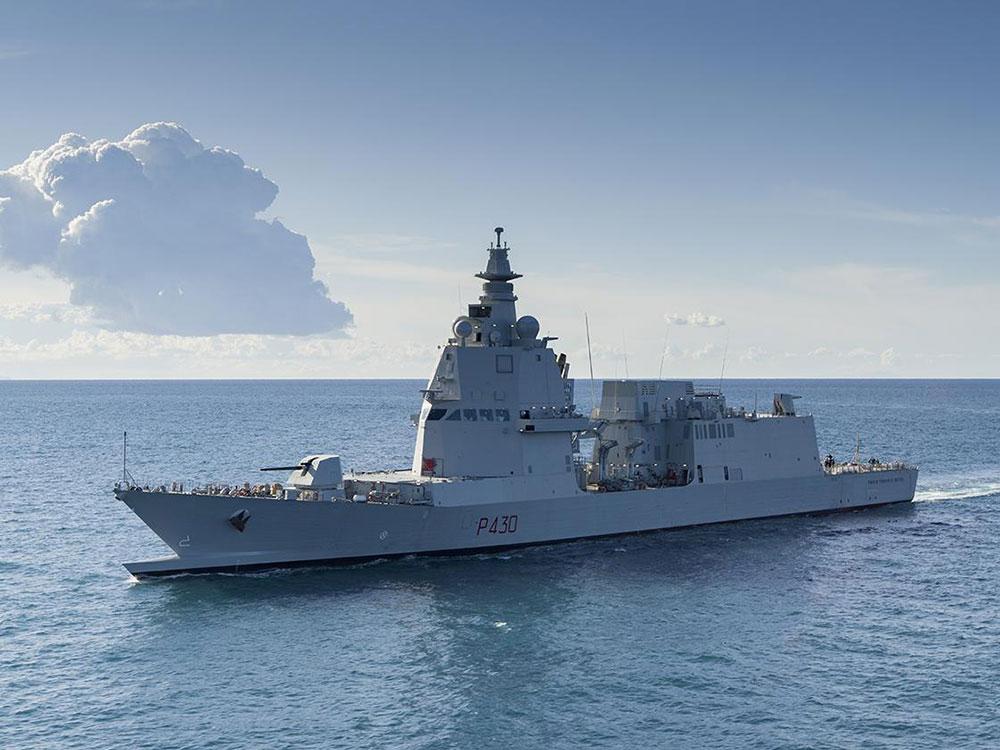
Leonardo and Seastema (Fincantieri Group) have come together to develop a revolutionary integrated workstation, which was the outcome of the Italian Navy’s specific request for a new guidance instrument in the wheelhouse capable of providing the essential functions of steering and combat with a minimal crew. This innovative feature in warship design is being incorporated into seven patrol vessels being built for the Italian Navy as part of its special fleet modernisation programme, along with the amphibious ship (LHD TRIESTE) and logistics ship (LSS VULCANO). The research, design and production that went into this system was a major undertaking. The work was facilitated, however, by the architecture and some features held in common with Leonardo’s ATHENA MK.2/SADOC4 CMS, on which it was based.
The naval cockpit requires only two operators – a pilot and co-pilot, to conduct ship and air operations. It incorporates the figures of the bridge watch officer and the commander. This workstation enables operation of the machines, rudders, platform systems, and some Combat Management System (CMS) functions, including the weapons equipment. In the new bridge the commander sits behind the two operators in a special seat equipped with controls, allow the commander to interact with the two operators mentioned above and the CMS operators, while the pilot and co-pilot use joysticks, engine throttles and control knobs similar to those of aircraft cockpits.
A central console between the two operators with a large number of switches, lights and knobs also contributes to the ‘cockpit-like’ atmosphere. However, the cockpit configuration, remains unique as it is being designed for a warship and was conceived in close cooperation with the customer. This configuration also directly impacts the layout and fitting out of the bridge interiors and the ship’s operation. In a further drive to integration, the cockpit may also be used in the future for naval units with a different CMS.
The revolution brought about by the new naval cockpit becomes clearer if one considers the fact that until now the minimum crew on the bridge comprised the commander, 2-3 helmsmen, a communications officer and seven CMS operators. The current configuration reduces this to seven people – commander, pilot, co-pilot and four CMS operators (communications, radar, sonar, etc.). The cockpit also cuts the unit’s rapid response time to sudden threats by maintaining the ship in a high state of readiness.
Two operators have direct access to point-defence weapons, allowing them to react promptly – on the commander’s order – to sudden threats such as fast-moving boats or unmanned aircraft. Faced with more complex threats, immediate access to sensors and weapons saves valuable time while waiting for the crew to arrive at battle stations and to determine a broader and more coherent response. Cockpit operators have access to all the ship’s optical sensors for steering and manoeuvring functions, at sea and in port. Each unit has an all-round view with day, night and infrared cameras.
With the entry into service of the Paolo Thaon di Revel – the first of the seven planned PPAs – and the ongoing preparation of the next vessels due to be launched, personnel training is already underway and bean during the warship’s first voyages at sea. This allowed for on-the-job training for the officers chosen for this new assignment. The training process also takes place at Navy institutions using simulation systems, and at Leonardo and Seastema. The training course eventually leads to the exclusive certificate of ‘naval cockpit operator’.
The naval cockpit has room for further evolution, however, and the system has already been designed to accommodate any such developments easily. The most prominent of these, already outlined in the initial study, involves using Augmented Reality (AR) to suggest new manoeuvring features and an even more effective presentation of information.
These features will become more easily integrated and affordable as the enabling technologies mature. Leonardo has already carried out studies in this sector, which will in the future see a continuous exchange of information with the Italian Navy based on operational experience that ships equipped with the new cockpit will begin to gain.

Headquartered in Singapore with reporters spread across all major regions, GBP Aerospace & Defence is a leading media house that publishes three publications that serve the aerospace and defence sector - Asian Defence Technology, Asian Airlines & Aerospace and Daily News. Known industry-wide for quality journalism, GBP Aerospace & Defence is present at more international tradeshows and exhibitions than any other competing publication in the region.
For over three decades, our award-winning team of reporters has been producing top-notch content to help readers stay abreast of the latest developements in the field of commercial aviation, MRO, defence, and Space.
Copyright 2024. GBP. All Rights Reserved.